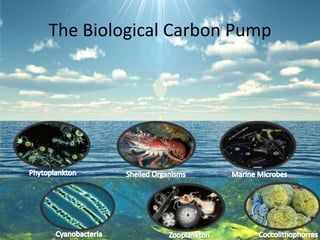
Ocean Biological Pump
- 1. The Biological Carbon Pump
- 2. Biological Carbon Pump Is a process by which CO2 in surface ocean water is transformed by ocean organisms into carbon compounds used to build living matter. These carbon compounds are transferred to deep ocean layers through dead organisms, fecal material and calcified skeletons and shells. Biological Pump Physical Pump
- 3. The Biological Carbon Pump removes and stores dissolved ocean CO2 through two different processes: 1. Photosynthesis and food chains 2. Shell-building organisms
- 4. Removal by Photosynthesis Like trees on land, countless unicellular microscopic plants called phytoplankton absorb CO2 from ocean surface water. Large phytoplankton blooms occur when plenty of sunlight, CO2 and nutrients are available. Important nutrients include nitrogen, iron and B12.
- 5. Phytoplankton Photosynthesis Phytoplankton use energy from Sun, CO2 and H20 to photosynthesize
- 6. Cell Respiration Like all living things, phytoplankton respire. When phytoplankton break down the food they produced from photosynthesis, they release energy and some CO2 is released back into the water. Some respired CO2 “undissolves” and goes back into the atmosphere. Some respired CO2 is taken up by phytoplankton, shell-building organisms and some moves into ocean currents.
- 8. Food Chains and Consumption Tiny zooplankton (floating animals) consume phytoplankton for food and energy. Thus, carbon compounds are moved into the food chain.
- 9. Photosynthesis Phytoplankton Respiration ZooplanktonConsumed by Respiration Higher Level Consumers Consumed by
- 10. Decomposers, Feces and Dead Stuff – Oh My! • Most dead, decaying bodies and fecal matter are dissolved by ocean water, decomposed by bacteria, or consumed by animals as they slowly sink towards the bottom of the ocean. • Only a small amount reaches the bottom sediments (about 1-2%) • Bacterial decomposition releases CO2 into the cold water of the deep ocean currents during respiration. • Thus, carbon may stay in deep ocean currents for hundreds of years and in sediments for thousands to millions of years.
- 12. Photosynthesis Phytoplankton Respiration Zooplankton Decomposition Consumed by Bacteria Higher Level Consumers Consumed by Decomposition Ocean Sediment Respiration
- 13. Stop and Think: If phytoplankton populations decreased, you might expect: A. CO2 in the atmosphere to decrease B. CO2 in the atmosphere to increase Explain your choice!
- 14. Removal of CO2 by Shell-building organisms
- 15. Use of CO2 by Shell-building Organisms • Shell-building phytoplankton and animals build their shells from carbonate ions. • The carbonate ions are produced when dissolved CO2 combines with seawater H20 to produce carbonic acid(H2CO3), bicarbonate(HCO3-) and carbonate ions (CO32-)
- 16. When shelled organisms die, their shells sink to the bottom of the oceans and accumulate as carbonate-rich ocean sediments. However, most shells dissolve before reaching bottom sediments, especially in deep, cold water! Most of the carbon that reaches deep ocean sediments are from shell-building plankton like the foraminifera and coccolithophores pictured below.
- 17. Some carbon-rich ocean sediments eventually become part of the rock cycle. This time scale takes millions of years.
- 18. Take Home Point! The Biological Pump plays a central role in the stability of the global carbon cycle by removing CO2 from atmosphere and storing carbon compounds in: 1. Food Chains (for short time scales - minutes to years) 2. Shells (for medium – very long time scales – years to millions of years ) 3. Deep Ocean Currents (for long time scales – hundreds of years) 4. Sediments (for very long time scales – millions of years)
- 19. Stop and Think 2. Many mountain tops contain fossils of shelled creatures that once lived in the ocean. Carbon is locked up in these fossils. Which of the Earth’s spheres could this carbon have traveled through on its journey to these mountain-tops? A. Geosphere B. Geosphere and biosphere C. Geosphere, biosphere and hydrosphere D. Geosphere, biosphere, hydrosphere and atmosphere
- 20. Credits Created by Barbara MacEachern and Candace Dunlap TERC Zooplankton/Phytoplankton images: Plankton chronicles http://www.planktonchronicles.org/en/episode/11
Hinweis der Redaktion
- Possible heading Phytoplankton use energy from Sun, CO2 and H20 to photosynthesize/.
- Can we need to draw CO2 and C in here.
- coccolithofores
- Image of a crab or lobster here or coccolithophoreIs there any way to make the picture of the reaction clearer?
- Picture of coccolithophores and forams
- I want to use one or the other – which ever can be made clearer.